| 1 |
Head distinctly
rectangular with most of the sides parallel |
2 |
| -- |
Head with convex sides and quite strongly
rounded posterior corners |
3 |
| . |
Head
distinctly rectangular |
. |
| 2 |
 TL 2.8-6.5 mm (22
workers found); reddish brown; not as pale as punicus [juvenculus?],
gaster slightly paler than the alitrunk; mandibles, funiculuus, frontal
carinae and anterior clypeus brownish; head with much finer
puncturation than the type fulvus; head with more parallel
sides (cf saharensis); pygidium more strongly impressed than juvenculus
and punicus TL 2.8-6.5 mm (22
workers found); reddish brown; not as pale as punicus [juvenculus?],
gaster slightly paler than the alitrunk; mandibles, funiculuus, frontal
carinae and anterior clypeus brownish; head with much finer
puncturation than the type fulvus; head with more parallel
sides (cf saharensis); pygidium more strongly impressed than juvenculus
and punicus |
Ivory
Coast - (impressus) mordax |
| -- |
 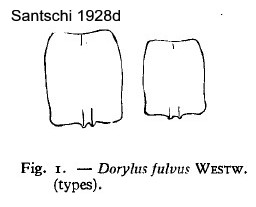 Major TL 9.0 mm, HW 1.7, HL
2.1, SI 45; castaneous, head palest (anterior margin blackish),
alitrunk and
petiole slightly darker, scapes and funiculi more so; mandible
castaneous with the apex black; shiny; head with minute punctures
anteriorly; alitrunk with larger punctures and a reticulate ground
sculpture; petiole with minute punctures and faintly reticulate,
petiole from above subtruncate anteriorly, posterior angles rounded,
ventral process angular Major TL 9.0 mm, HW 1.7, HL
2.1, SI 45; castaneous, head palest (anterior margin blackish),
alitrunk and
petiole slightly darker, scapes and funiculi more so; mandible
castaneous with the apex black; shiny; head with minute punctures
anteriorly; alitrunk with larger punctures and a reticulate ground
sculpture; petiole with minute punctures and faintly reticulate,
petiole from above subtruncate anteriorly, posterior angles rounded,
ventral process angular |
. |
| . |
 |
. |
| . |
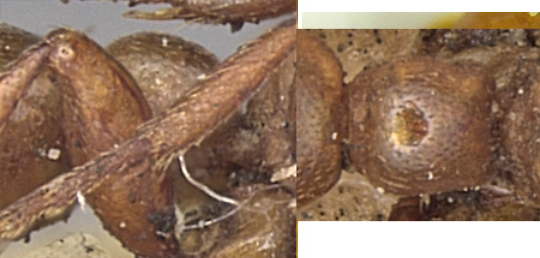 |
West Africa & Congo
Basin - fulvus |
| ¤ |
 Major TL 14 mm; straw
colour with a darker head; mandibles and legs dark brown Major TL 14 mm; straw
colour with a darker head; mandibles and legs dark brown |
Cameroun
- stramineus |
| ¤ |
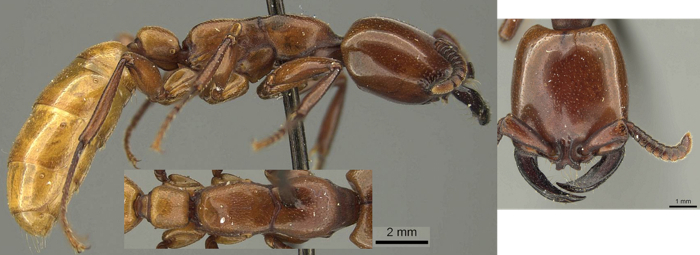 Major
TL 14 mm; red-brown; head with
larger puncturations; major mandible dorsum black, with a single basal
tooth Major
TL 14 mm; red-brown; head with
larger puncturations; major mandible dorsum black, with a single basal
tooth |
Zaire - dentifrons |
| -- |
 TL
ca 10 mm; frontal carinae markedly projecting forward; scapes very
short SI 30; longitudinal groove on propodeum clearly visible; petiole
sub-rectangular, longer than wide; head smooth and shiny TL
ca 10 mm; frontal carinae markedly projecting forward; scapes very
short SI 30; longitudinal groove on propodeum clearly visible; petiole
sub-rectangular, longer than wide; head smooth and shiny
|
. |
| . |
 |
North
Africa - oraniensis |
| -- |
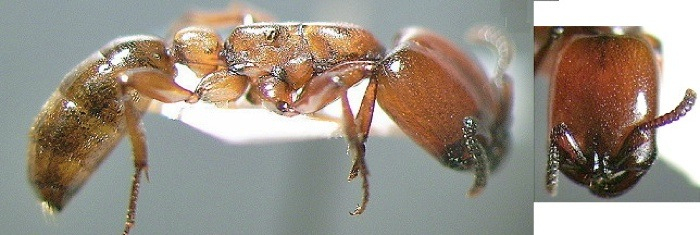 < TL 12 mm, SI 45; head
distinctly punctate; head mahogany red, alitrunk, scape and legs
paler, gaster amber < TL 12 mm, SI 45; head
distinctly punctate; head mahogany red, alitrunk, scape and legs
paler, gaster amber
|
. |
| . |
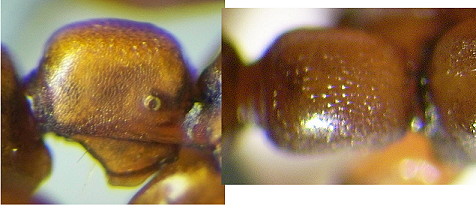 |
Kenya-Sudan-Ethiopia - eurous |
| . |
Head
with convex sides and quite strongly rounded posterior corners |
. |
| 3 |
Major TL < 10 mm |
4 |
| -- |
Major TL 11-12 mm |
5 |
| 4 |
 Major TL max 8 mm;
pale
coloured (paler than the type fulvus); head noticeably shorter
than eurous, occiput more feeblyimpressed that the type or badius;
HL ca 1/6 longer than HW, distinctly narrowed posteriorly, with more
rounded angles than the type; petiole node as wide as it is long, with
posterior angles more rounded than the type Major TL max 8 mm;
pale
coloured (paler than the type fulvus); head noticeably shorter
than eurous, occiput more feeblyimpressed that the type or badius;
HL ca 1/6 longer than HW, distinctly narrowed posteriorly, with more
rounded angles than the type; petiole node as wide as it is long, with
posterior angles more rounded than the type |
|
| . |
 |
Kenya-southwards
to Zimbabwe - rhodesiae |
| 5 |
Major head relatively
short and with weakly concave or bowed sides |
6 |
| -- |
 Major
head relatively longer with straighter sides Major
head relatively longer with straighter sides |
. |
|
 TL (punicus)
ca 2.0-10 mm; smooth and shiny, the
head an elongated rectangle, the gaster short; the alitrunk dorsum
flattened and the legs short; TL (punicus)
ca 2.0-10 mm; smooth and shiny, the
head an elongated rectangle, the gaster short; the alitrunk dorsum
flattened and the legs short; |
North Africa to
Israel - juvenculus
|
| 6 |
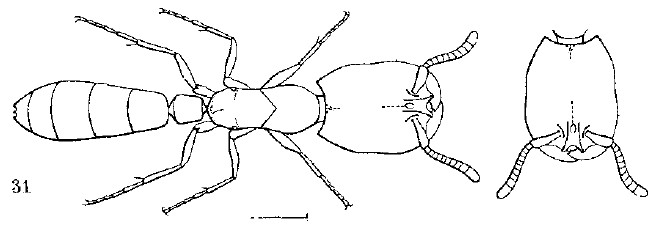 Major TL 13 mm; HW 2.8 HL 3.2;
base colour anterior dark castaneous red, progressively lightening,
gaster dark brownish-yellow; almost all very shiny; head sparsely
punctured with minute shallow punctures; petiole node sub-quadrate, as
long as it is wide, all the angles strongly rounded, with a triangular
ventral process Major TL 13 mm; HW 2.8 HL 3.2;
base colour anterior dark castaneous red, progressively lightening,
gaster dark brownish-yellow; almost all very shiny; head sparsely
punctured with minute shallow punctures; petiole node sub-quadrate, as
long as it is wide, all the angles strongly rounded, with a triangular
ventral process |
South
Africa - badius
|
| -- |
 TL 5-13 mm; head, alitrunk,
petiole and legs rich chestnut brown, gaster brownish yellow, mandibles
and antennae near black; smallest morphs more uniformly brownish
yellow; alitrunk with no more than fine sculpturation TL 5-13 mm; head, alitrunk,
petiole and legs rich chestnut brown, gaster brownish yellow, mandibles
and antennae near black; smallest morphs more uniformly brownish
yellow; alitrunk with no more than fine sculpturation |
. |
| . |
 |
Congo Basin - obscurior |